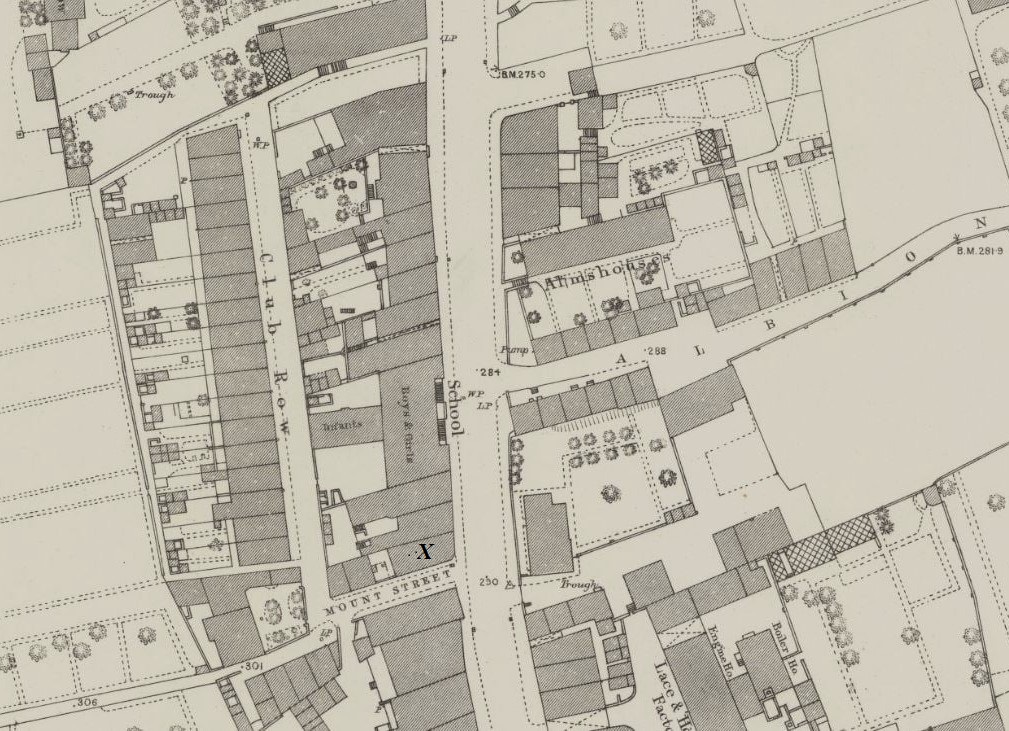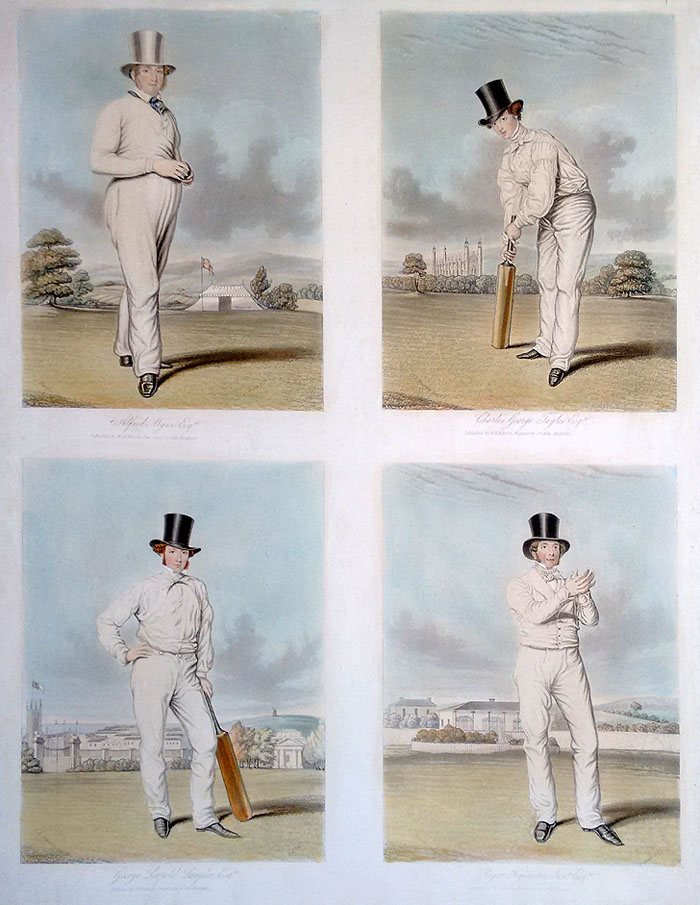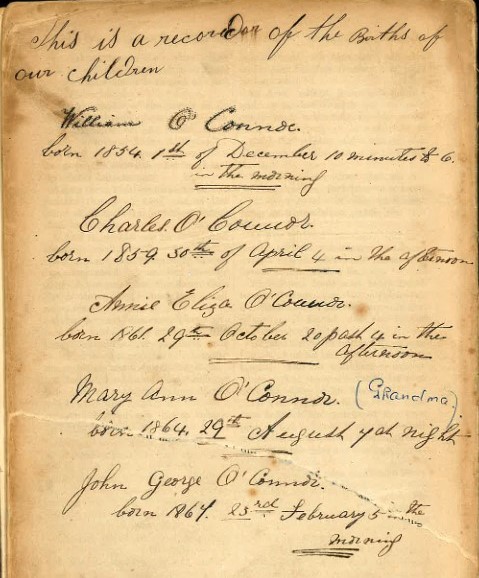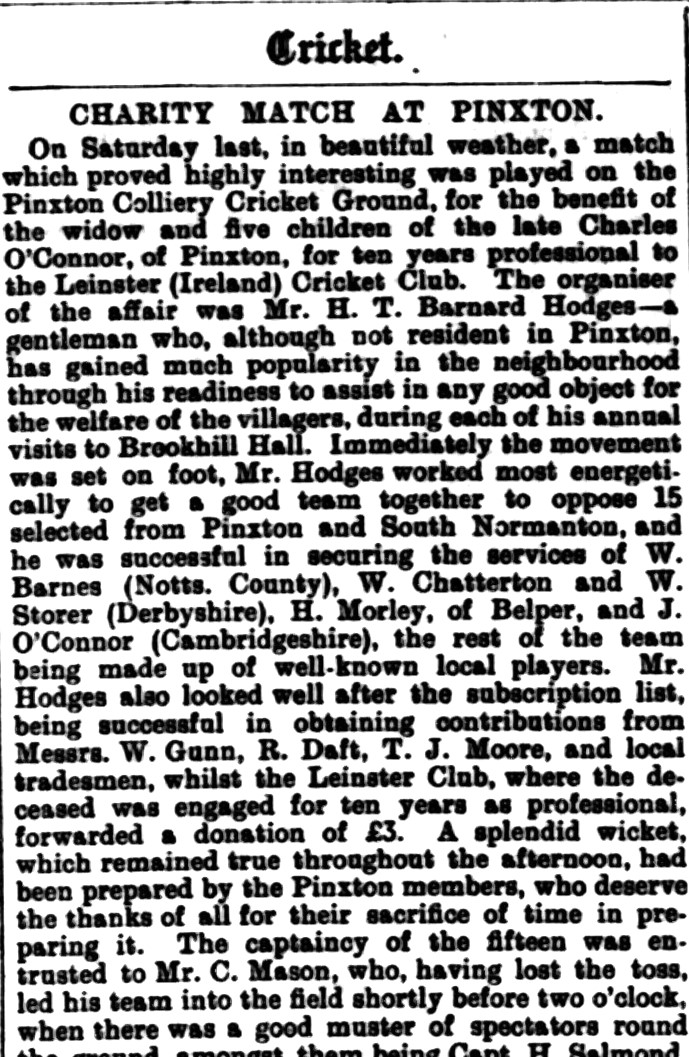According to Adeline Wells “Mr Paxton, who at that time was a noted cricketer, lived at the same house”…. that house would be sited on the north corner of Mount Street at its junction with Bath Street, and marked X on the 1879/81 map below.
Born about 1816, the son of framework knitter George and Hannah (nee Beardsley), John Paxton lived at least the latter part of his life in this Mount Street area.
He married Hannah Hofton on November 6th 1837, the bride being the daughter of framework knitter William and Sarah (nee Birkimshaw).
From 1838 until 1845 they had at least four children together, but on the 1851 census John is at Mount Street while Hannah is acting as ‘housekeeper’ for Edwin Riley at the Gallows Inn.
The 1861 census then records John still in Mount Street as a married lodger with Sarah Burgin-Richardson and at that time he was bailiff of the Derbyshire County Court for the Belper District. Hannah is living as a charwoman in Granby Street.
John had access to a stable in Mount Street where, one Saturday in 1863, he was keeping three hens and a cock which he had taken possession of, ‘as a distress’. When he came to visit them on Sunday morning two hens had been killed, only their heads remaining to greet John. However the bailiff was able to follow a trail of feathers for about 100 yards from the stable to a wall nearly opposite the home of collier Herbert Green in Mount Street.
Police Inspector Edward Brady was soon on the case and accompanied by John he entered the then empty house where, in the fire grate, they found a fowl’s rump and bones, and feathers suspiciously like those of the dead hens. When Herbert returned home he was charged with theft but pleaded ignorance of the crime — the blood and feathers sticking to the right leg of his trousers he could not explain to the satisfaction of Inspector Brady who promptly took him to the lock-up.
At Ilkeston Petty Sessions a few days later, Herbert admitted his guilt and said he was very sorry for what he had done.
He was sentenced to one month’s imprisonment instead of the customary three months, after John had pleaded for mitigation on his behalf.
Herbert Green, alias ‘Bruzzer’, was born Herbert Grimley on September 5th, 1843, the illegitimate son of glove stitcher Ann Grimley and needlemaker William Castleton alias Green.
When his mother married William in 1847 Herbert, along with Ann’s illegitimate daughters, Charlotte and Emma, adopted the Green surname.
———————————————————————————————————————–
John Paxton was an extremely fast and deadly bowler for Rutland Cricket Club with a very pronounced local reputation but a very short ‘first-class cricket‘ career. It lasted for one match when John played for the North of England against the South, August 30th-31st 1848 at Leamington Spa. In his side’s one innings he opened the batting but was out for a duck, he took no wickets but did make two catches. And his side won by an impressive nine wickets. (see ESPNcricinfo for more details)
Victorian Cricketers by Charles John Baseby 1841
John was one-time secretary of the Ilkeston Rutland Cricket Club and was responsible for the challenge below. At this time Slater’s Directory of Derbyshire describes him as a retailer of beer, trading in Bath Street. This would probably have been at his premises on the corner of Mount Street (map above) and which is referred to as “the Cricketers’Arms” in that challenge. This name appears again, later in the 1860s, by which time the Anchor Inn in Market Street had been built and the name was briefly attached to that establishment.
from Bell’s Life in London (June 1849)
————————————————————————————————————————
John Paxton died on December 8th, 1868, aged 52 …. “his end was not unexpected and his long affliction had been borne with exemplary fortitude”. (IP)
“I have good reasons for recollecting the day of his funeral. Ugh! How it rained! It fairly ran out the top of your boots, and with it came the lightning and thunder. It was this which impressed the day so forcibly on my mind” (Sheddie Kyme)
————————————————————————————————————————
John’s successor as bailiff for the County Court was carriage proprietor William Thorpe of Heanor who was requested by his new employer to leave his home town and reside in Ilkeston. But hardly had he taken up his new post than he was perhaps regretting it.
In the execution of his duty the bailiff visited the premises of lacemaker William Carrier, accompanied by P.C. Baker and carrying a warrant to levy on William’s goods. A scuffle ensued and the lacemaker bit the bailiff’s thumb, causing it to bleed. And then for good measure he bit the constable’s thumb.
For this he found himself at Heanor Petty Sessions and promptly paid his fine, anxious to avoid a month in prison with hard labour.
Three days after this affray — nursing his sore thumb and again in the execution of his duty — William Thorpe found himself at the home of miner William Slater in Sisson’s Row.
Another fight and another assault on bailiff William, this one involving a flailing red-hot poker and a flying saucepan.
Just over a year later William Thorpe had left his job, left his wife and family, left the town, left the district and left behind many serious debts and angry defendants. He had absconded, having embezzled monies which he should have paid into the court.
Gap alert! …. What happened to William Thorpe of Heanor after this?
The post of bailiff for the district was then filled by Harry Morley Brand who would ‘infuse a little more respectability and soberness’into the role. (IT)
————————————————————————————————————————
The children of John and Hannah Paxton.
(A) Born in 1838 Eliza was the oldest child.
While still living in Ilkeston she gave birth to at least two illegitimate daughters — Sarah Ann born on August 12th 1859 who died on November 29th of the same year, and Harriet, born on November 10th 1860.
The latter accompanied her mother when she went north to live in Chesterfield in the early 1860’s.
And in Chesterfield Eliza had her illegitimate son Ephraim Paxton, born in early 1864.
And then on February 1st, 1864 in Chesterfield Eliza married (the probable father of her son) Elijah Reeve of Ilkeston, the coalminer son of Thomas and Eliza (nee Shaw).
Before his marriage Elijah had had a troubled life. On July 29th 1851 he was convicted at Derby Assizes of the manslaughter of framework knitter John Wheatley at Ilkeston and was sentenced to seven years transportation. He served part of his sentence at Portsmouth prison before being released on licence in June 1855. At this time he was described by his prison records as a 24 year-old, illiterate collier, 5 feet 4 inches tall.
And then — for me — he disappears for some years until his marriage in 1864, after which the Reeves moved to Attercliffe, Sheffield where two more children were born — Annie Reeve in 1868, and Lilly Reeve born in 1870.
Gap alert!! … Where was Elijah on the 1861 census?
Elijah had a younger brother Ephraim who, on July 6th, 1858 married Shipley-born Mary Ann Limb and shortly after moved north where he can be found at Staveley on the 1861 census. On the 1871 census he and his family are at 19 Hope Terrace, off Carbrook Lane in Attercliffe, Sheffield.
However your eye might be drawn to the family at the next house … at number 21 … which I list here …
Eli Shaw, aged 46, coalminer of ‘Notts’.
wife Eliza Shaw, aged 30, of ‘Ilkingston’, Derbyshire.
daughter Harriett Shaw aged 11, also of ‘Ilkingston’.
son Ephraim Shaw, aged 7, a scholar of Chesterfield, Derbyshire.
daughter Annie Shaw, aged 4 of Sheffield.
and daughter Lilley, aged 7 months, also of Sheffield.
(reminder — Elijah’s mother was born Eliza Shaw)
I believe that Eliza Shaw alias Reeve (nee Paxton) died in Sheffield in 1879 and Elijah then returned to Ilkeston. On the 1881 census he is living with his widowed mother Eliza Reeve, close to the Flower Pot Inn in Chapel Street.
Both Elijah and mother Eliza died in the following year.
(B) George Paxton was born on October 17th , 1840 and died from smallpox — after he had been vaccinated — on March 13th, 1841.
(C) George (the second) was born in 1842 and married Awsworth-born Ruth Burrows in 1865. He then lived most of his married life as a collier in Awsworth where he died in 1903.
(D) Harriet was born on January 14th, 1845. And then …?
Gap alert !! … on the 1851 census Harriet appears with her family at their Mount Street home. But what happened to her after that ??
My thanks to Martin Jackson for filling this gap. Harriet is Martin’s great great grandmother on his mother’s side; he writes …
Harriet Paxton the daughter of John and Hannah can be found in Derby in the 1861 Census living and working as a 16 year old children’s nurse for the celebrated early photographer Richard Keene (see entry in Wikipedia).
In 1871 she is living as a lodger in Clay Cross near Chesterfield and calling herself Harriet Barber.
By 1881 she has married a man called William Barber and is running a pub in the Whittington Moor area of Chesterfield called the Traveller’s Rest. Sadly she didn’t make old bones and died in 1890 in Chesterfield. She left one son George Barber who was my great grandad.
Interestingly her granddaughter Harriet Paxton Barber also ran the Traveller’s Rest during the 1940’s.
And Martin adds … I would be interested in anyone with any more info on the Paxtons.
————————————————————————————————————————
And after Mrs. Burgin’s butcher’s shop, Mrs. Boy’s Girls’ school.






